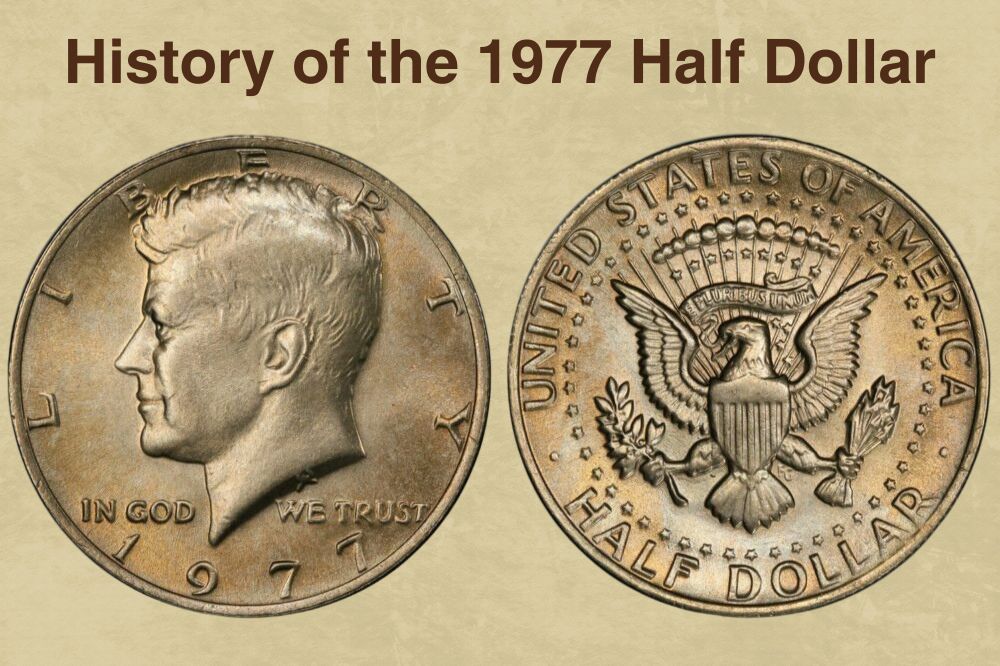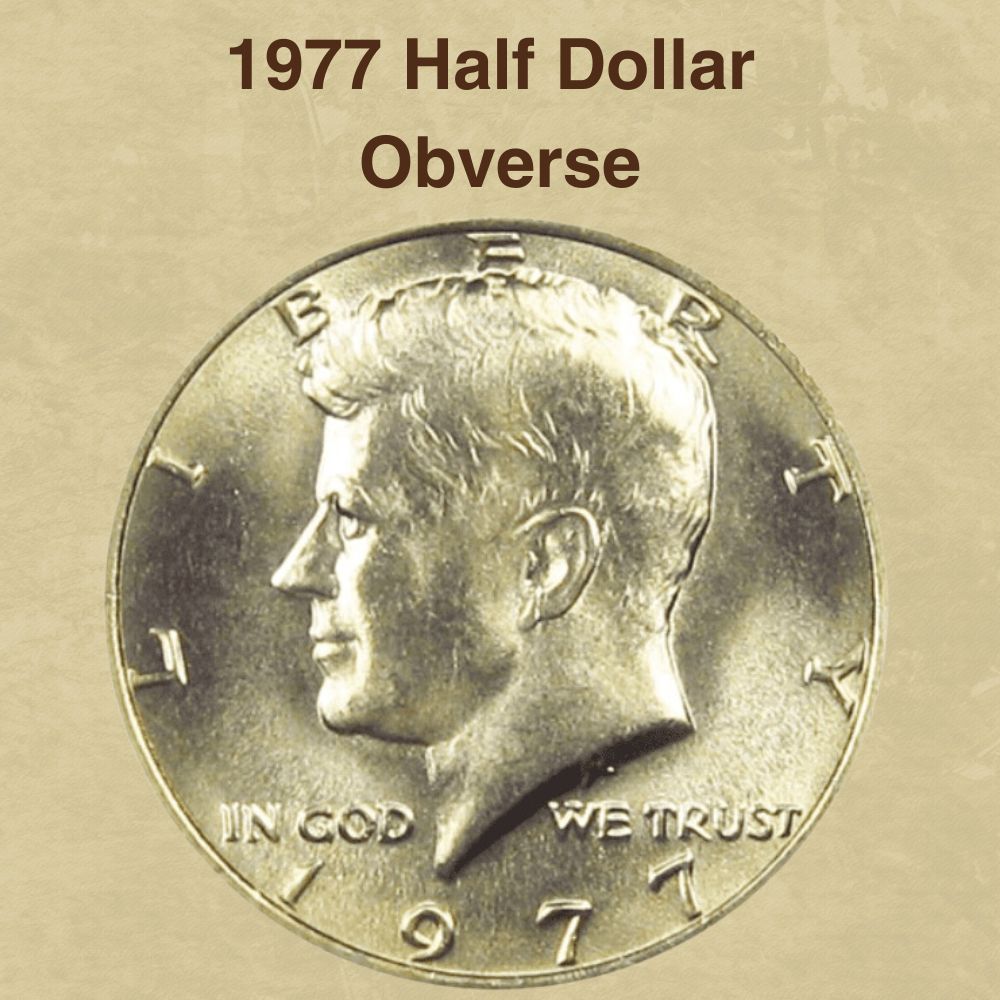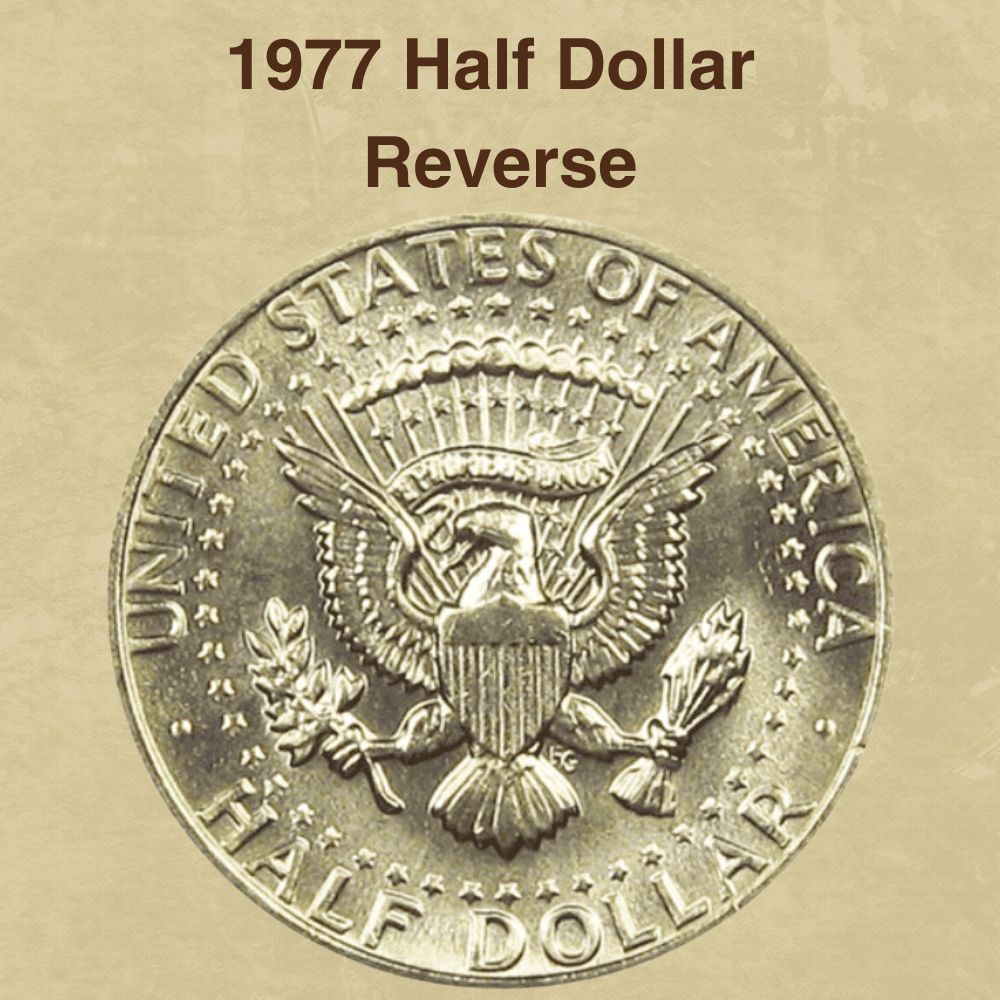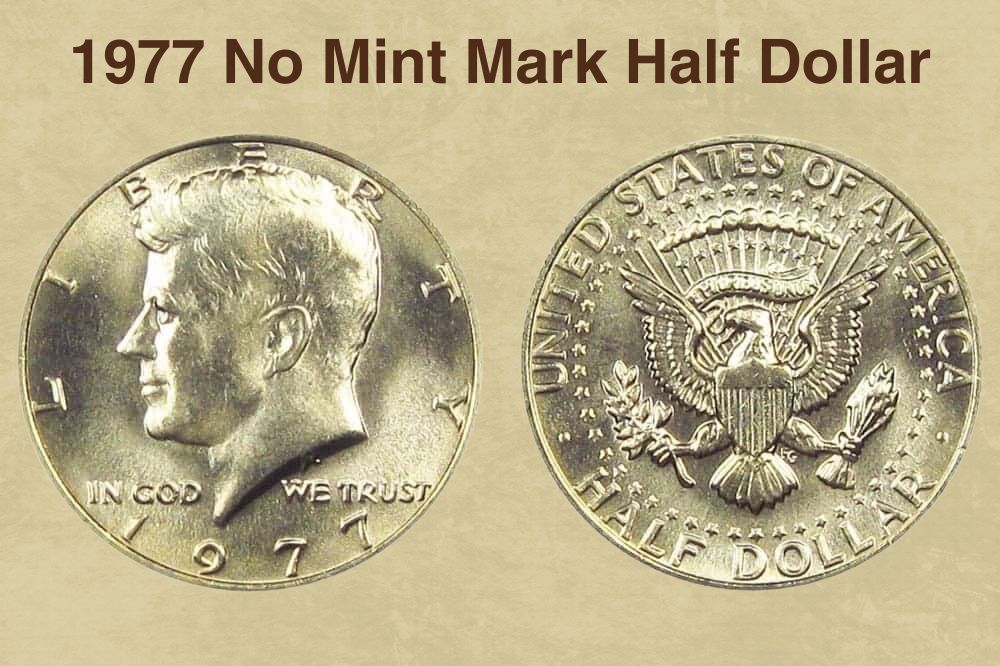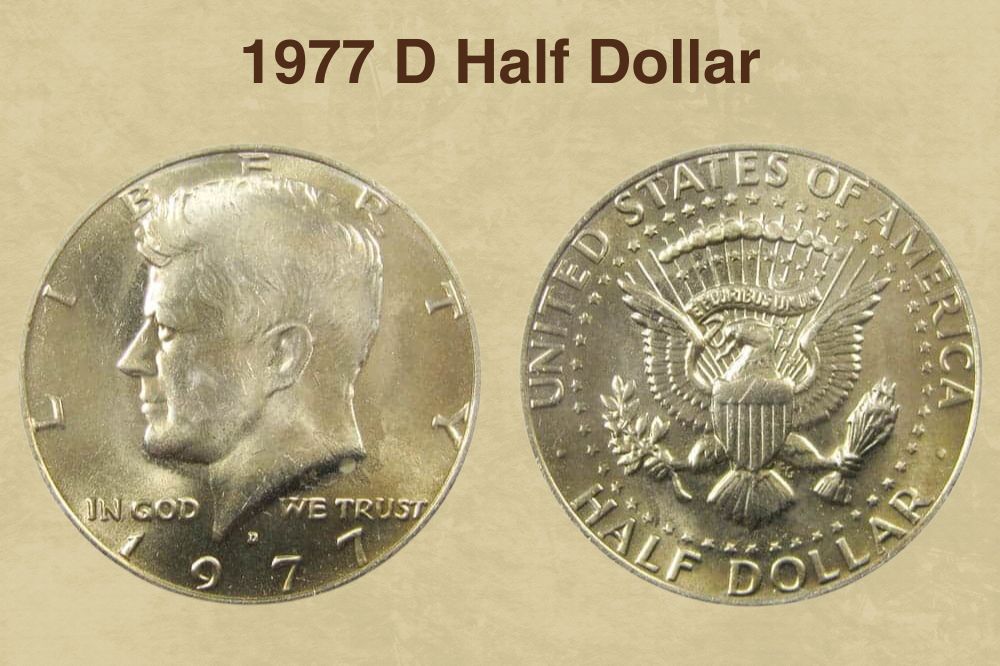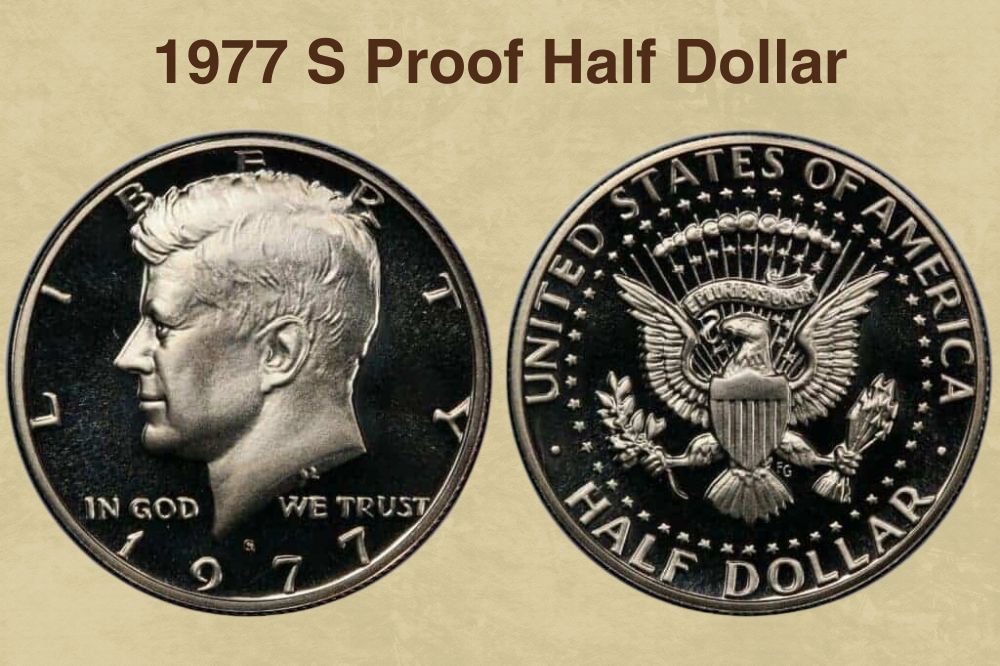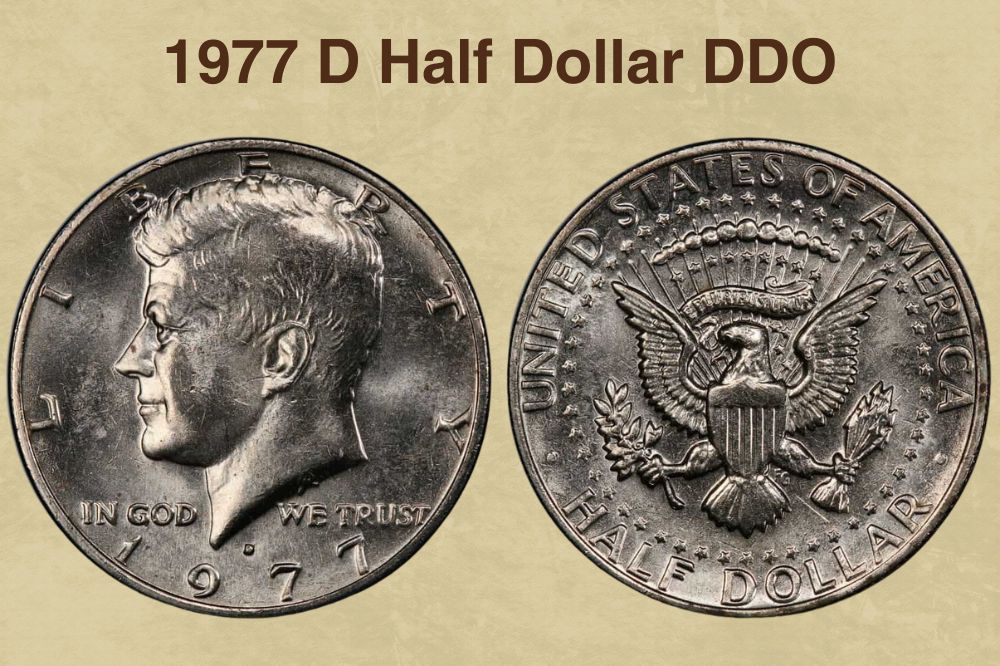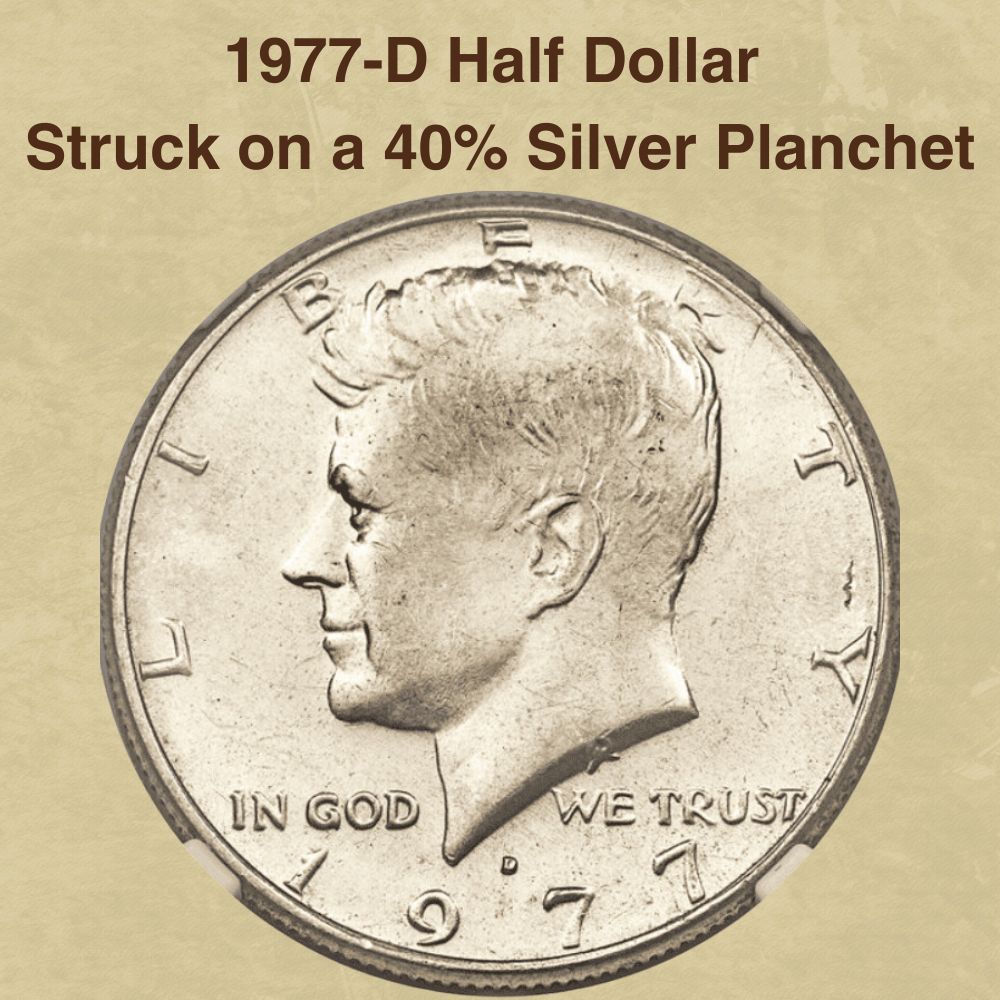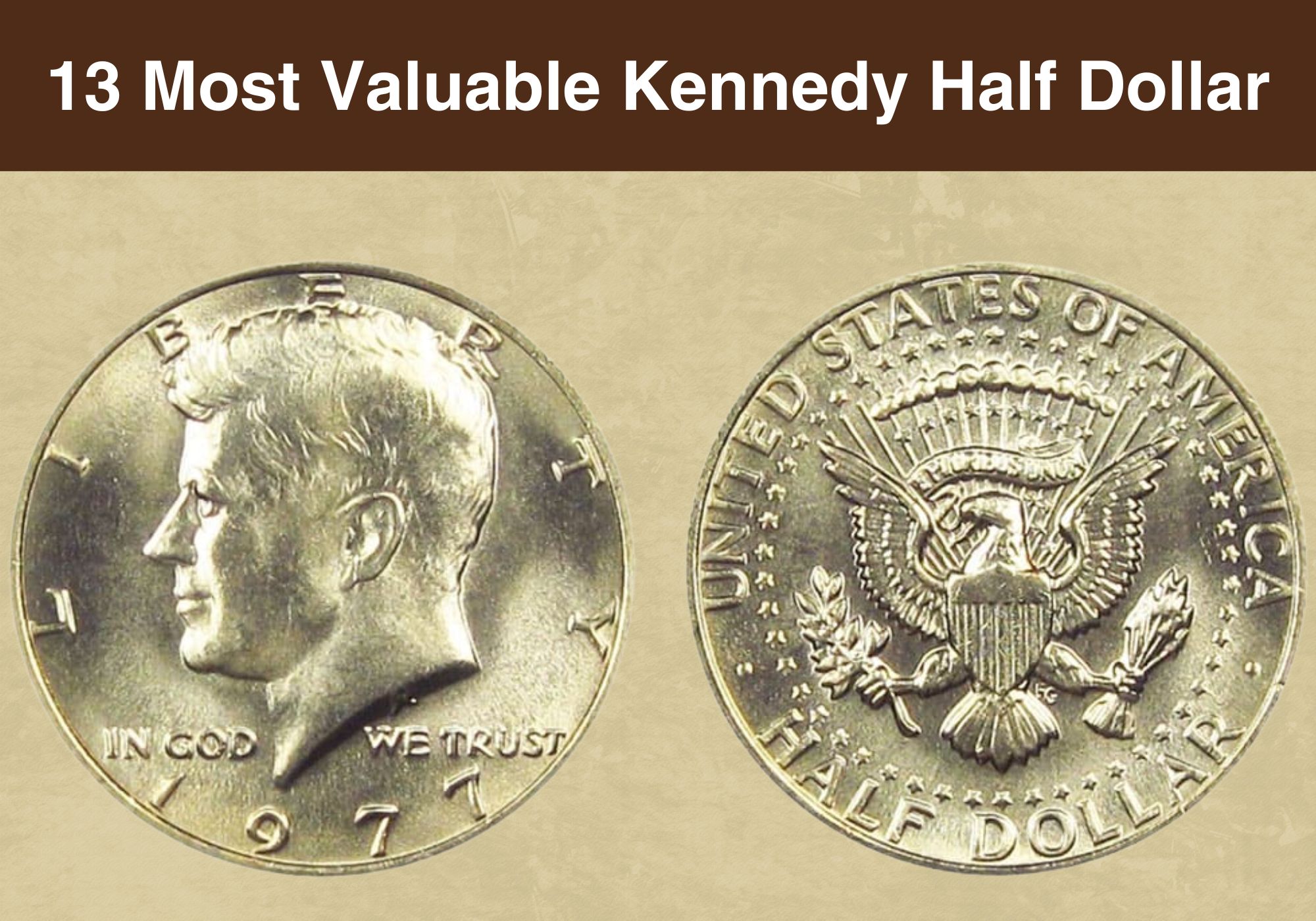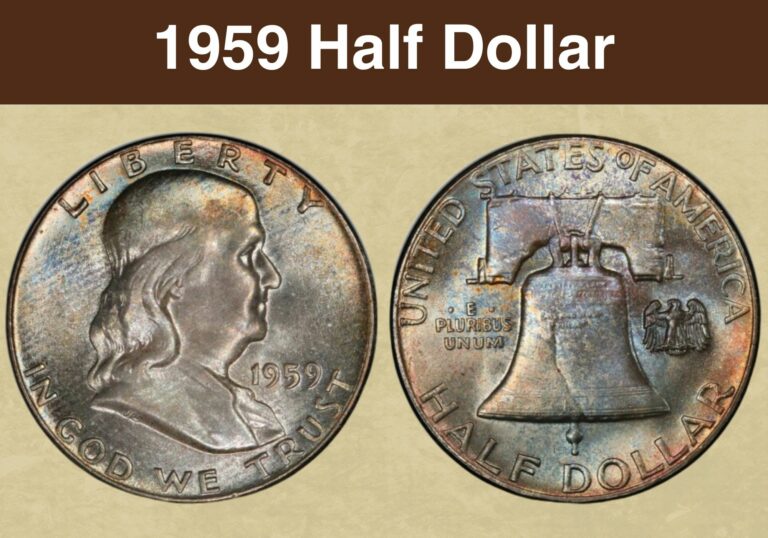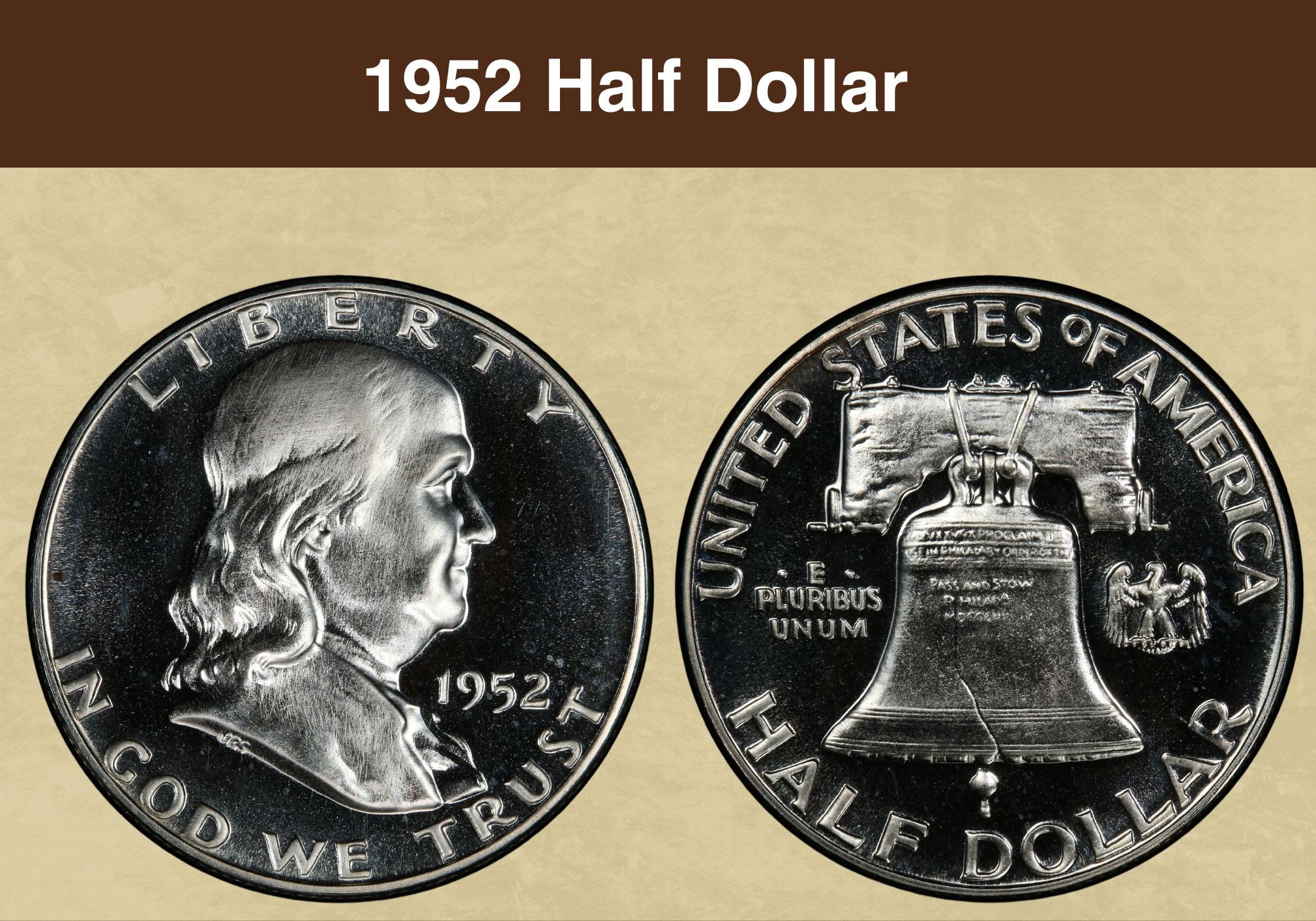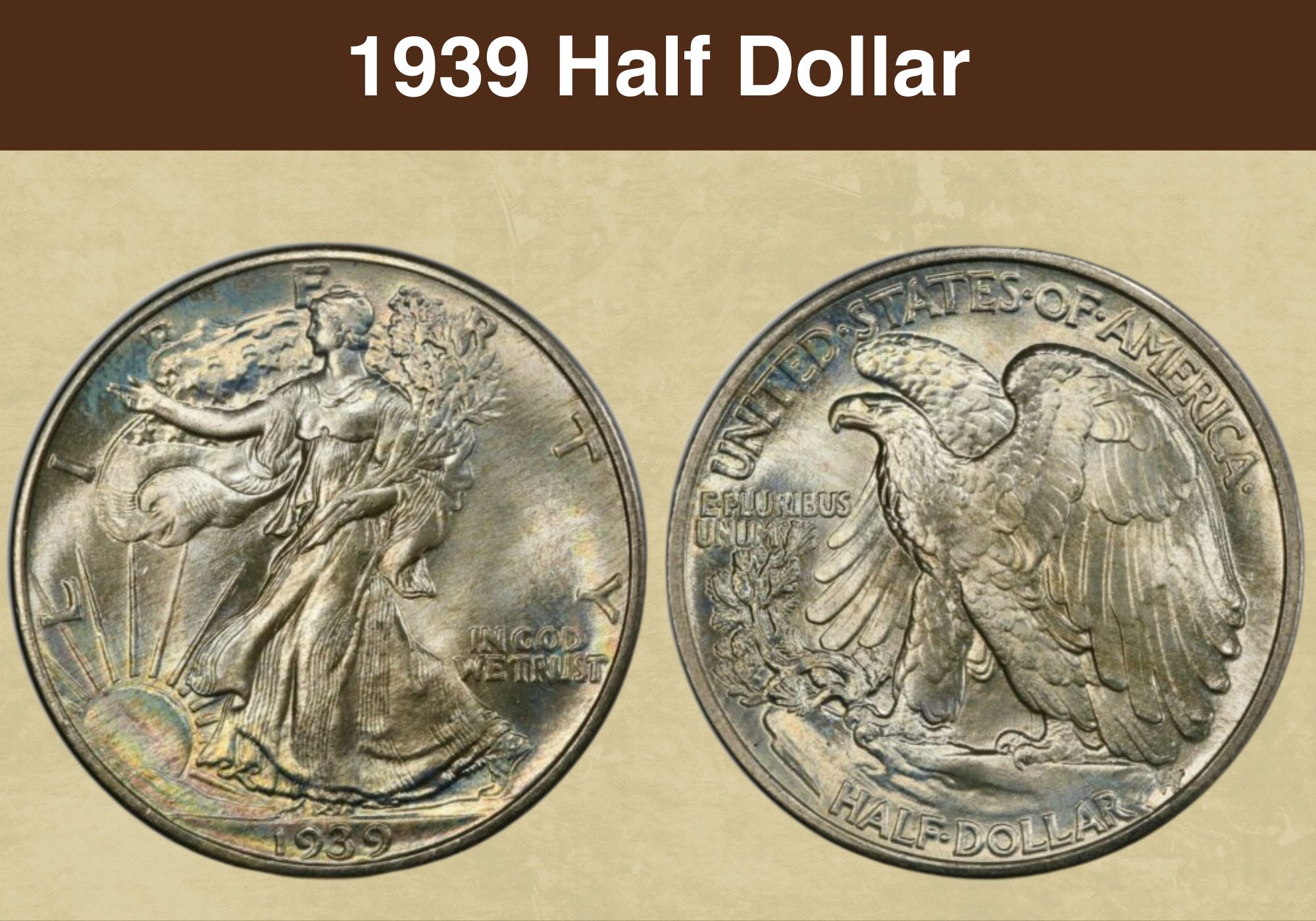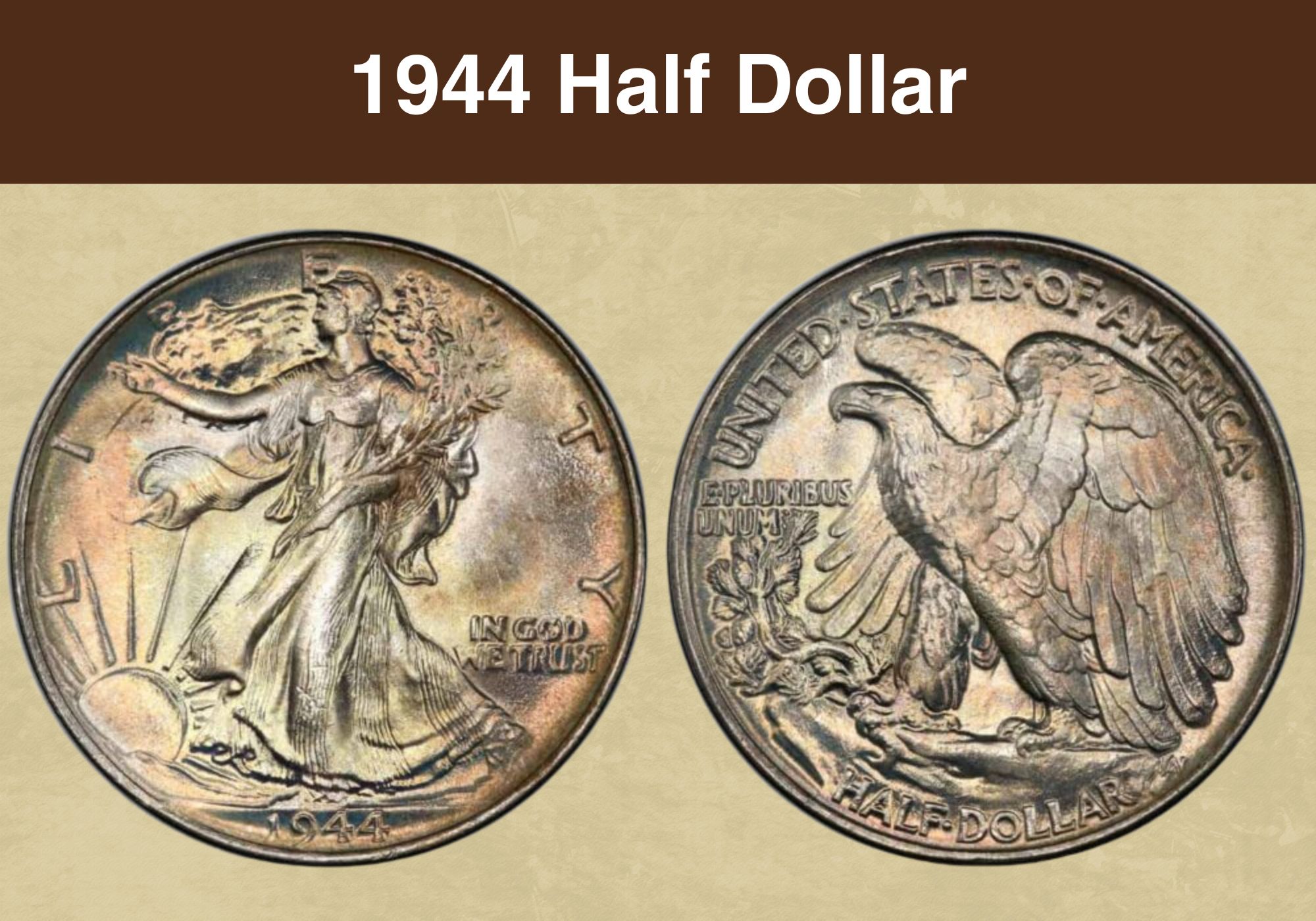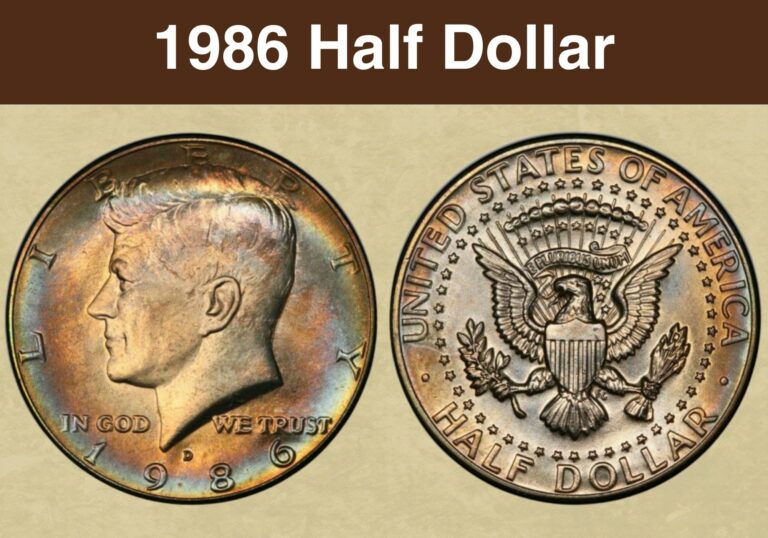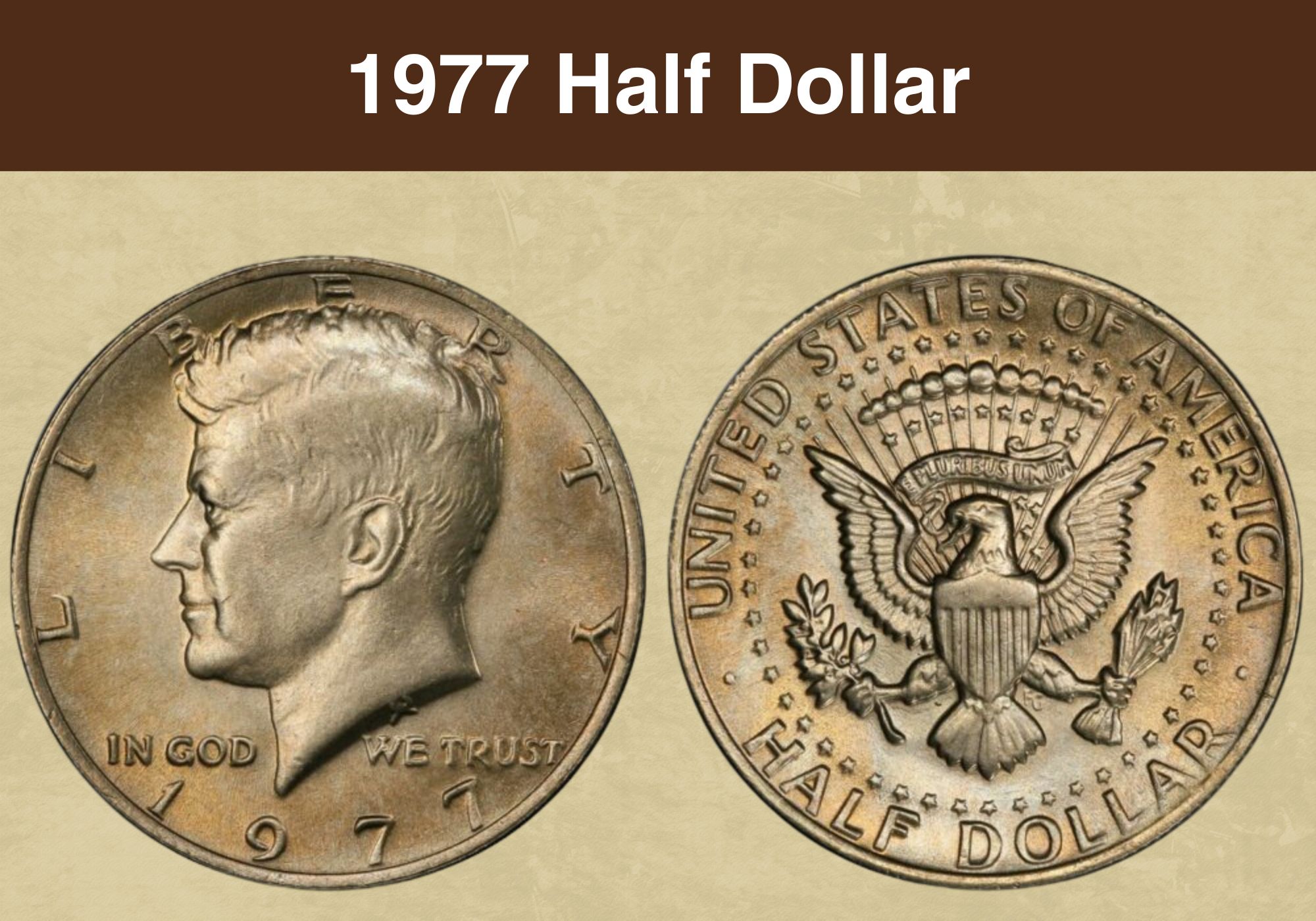
Coin Value Contents Table
- 1977 Half Dollar Value Chart
- History of the 1977 Half Dollar
- Features of the 1977 Half Dollar
- 1977 Half Dollar Grading
- 1977 Half Dollar Value Guides
- 1977 No Mint Mark Half Dollar Value
- 1977-D Half Dollar Value
- 1977-S Proof Half Dollar Value
- Rare 1977 Half Dollar Errors List
- Where to Sell Your 1977 Half Dollar ?
- 1977 Half Dollar FAQ
Since $1 coins are rarely used in daily transactions, the Half Dollar is the largest circulating coin, both in size and denomination. It features John F. Kennedy, one of the most popular presidents in US history. Let’s learn more about the 1977 Half Dollar Value and its statistics.
1977 Half Dollar Value Chart |
||||||
| Coin | MS 60 | MS 62 | MS 64+ | MS 66 | MS 67+ | PR/PF 70 DCAM |
| 1977 (P) No Mint Mark Half Dollar | $7 | $9 | $18 | $42 | $1,300 | – |
| 1977-D Half Dollar | $5 | $7 | $12 | $65 | $2,200 | – |
| 1977-S Proof Half Dollar | $4 | $6 | – | $11 | $11 | $65 |
History of the 1977 Half Dollar
The story of the Half Dollar is often wrapped in conspiracy. This is because it was produced to mark the assassination of JFK, the 35th US President. And six decades later, wild theories still surround his death. That said, the coin itself proved quite popular, partly because JFK was so beloved. Another reason for its affinity was a by-product of the 1960s coin shortage.
The Kennedy Half Dollar came out in 1964. And in 1965, the other denominations dropped their silver content as part of the US Mint’s response to the silver spike of the sixties. But the Half Dollar reduced its silver quotient from 90% to 40% while the other coins removed silver entirely, replacing it with cupronickel cladding. This made the Half Dollar doubly desirable.
People hoarded it as JFK memorabilia, but they also stashed it for its silver melt value. But although the Half Dollar eventually joined the Johnson Sandwich family in 1971, it wasn’t seen in circulation until the mid-seventies. For reference, the Johnson Sandwich was the nickname for the cupronickel-clad metal composition that was passed by Lyndon Johnson.
The Fastest Coin in US History
As for the Kennedy Half Dollar itself, it was one of the quickest US coins to be approved and released. The urgency came from the national response to his death. And it was facilitated by the Chief Mint Engraver using Presidential Medals as the basis for the coin. JFK had already approved the medal portraits so it was a fuss-free process to translate it from medal to coin.
One other coin that was produced relatively fast was the Roosevelt Dime. FDR died on 12th April 1945 and the nation wanted a memorial coin produced by January 26th. This would have been his 64th birthday and would coincide with the March of Dimes anniversary, which began during his birthday week in 1938. But that coin took 9 months while this one took 4.
The front of the JFK 50c derived from the Presidential Series Medal while the back was from the Presidential Appreciation Medal. This design has remained constant since the day it was launched. The only time it changed was in 1976 for the Bicentennial when the US Seal was replaced by Independence Hall. That coin also had two dates instead of one – 1776 to 1976.
The Categories of Kennedy Half Dollars
Since so many people were interested in 1976 Bicentennial Half Dollars, the 1977 Half Dollar got some spill-over interest as well. But as we said at the beginning, Half Dollar and $1 coins are rather heavy so people avoid using them in daily trade. In 2001, the US Mint stopped making business strike Half Dollars for everyday use, though they resumed minting in 2021.
Kennedy Half Dollars come in five styles. The originals were 90% Silver and 10% Copper. This was also used for some proof coins after 1992. Next came Silver-Clad Half Dollars from 1965 to 1970. These were 40% Silver and 10% Copper. Some of the 1976 Bicentennial Proof Half Dollars were Silver-Clad as well. Starting in 1971, cupronickel-clad coins had copper cores.
Then from 1992, the San Francisco Mint resumed making some proofs in 90% Silver while the rest were cupronickel-clad. But 2014 marked the 50th Anniversary of the JFK Half Dollar so they made a mixture of cupronickel coins, 90% silver coins, and 99.9% gold coins. Some of the 90% Silver Half Dollars were Reverse Proofs. After 2019, Proofs were 99.9% Silver.
Also read: 13 Most Valuable Franklin Half Dollars Worth Money
Features of the 1977 Half Dollar
Numismatists are people who study and trade coins so they’re your safest source and it helps to learn their language. They call the heads side of a coin its obverse, the tails side its reverse, the thin side is its edge, the raised border is its collar or rim, the words are legends or mottos, the images are devices, and the background is the field. The coin blank is called a planchet.
The Obverse of the 1977 Half Dollar
It shows President John F. Kennedy facing left. The legend Liberty curls around his head, with BER partly hidden in his hair. In God We Trust flanks his neck with In God on the left and We Trust on the right. The neckline cut-off has GR above We for coin designer Gilroy Roberts. The bottom of the coin has the mint date with the mint mark above the 9 and 7.
The Reverse of the 1977 Half Dollar
It has United States of America along the upper rim and Half Dollar along the lower rim, with two dots separating the legends. The middle of the coin carries the US Seal – 50 stars circling an eagle that’s holding a shield, arrows, and an olive branch. Its beak has a ribbon with E Pluribus Unum plus clouds and stars above. FG for Frank Gasparro is above its tail.
Other Features of the 1977 Half Dollar
The 1977 Half Dollar is 91.67% Copper and 8.33% Silver. The core of the coin is pure copper and the outer cladding is 75% Copper and 25% Silver, so you can often see copper peeking through the 150 reeds on the coin edge. It measures 30.6mm in diameter, is 2.15mm thick, and weighs 11.34g. The easiest way to differentiate it from its silver (clad) cousins is by mass.
Also read: 13 Most Valuable Kennedy Half Dollar Worth Money
1977 Half Dollar Grading
Larger coins like Half Dollars spend most of their time in vaults and display cases. It’s why the Kennedy Half Dollars from 1970 to 1987 were sold exclusively as special collections. The coins are graded using the Sheldon Scale from 1 to 70. Proof coins are rated as PR by PCGS or PF by NGC. You can use online guides to get a general idea of coin condition and value.
1977 Half Dollar Value Guides
In 1977, Half Dollars were minted in Philadelphia, Denver, and San Francisco. From 1975, San Francisco focused on proof coins so their overall quality was much higher. This meant the coins lasted longer, but it also reduced resale value since it was easier to find high-grade samples. Also, while JFK Half Dollars weren’t commemorative, they still rarely circulated.
1977 No Mint Mark Half Dollar Value
In 1977, the Philadelphia Mint made 43,598,000 Half Dollars with no mint marks. And while eBay is probably the easiest way to sell a coin, their prices aren’t always reliable since they depend on the mood of the buyer. That said, the highest sale recorded for a 1977 MS 68 Half Dollar was $5,750. It was a fairly recent eBay sale and it happened on 19th February 2023.
For comparison, PCGS hasn’t received any MS 68s from 1977. But it has seen three coins graded MS 67+ and it places their August 2023 value at $1,300, much lower than eBay. Half a step down, with 175 coins graded MS 67, their estimated price is just $175 in August 2023. It only gets worse from there. Common coins graded AG 3 to AU 58+ are only worth a dollar.
Curiously, the lowest grades are rare, with only one or two known coins submitted. So a PO 1 can go for $50 while an FR 2 can be $10. Past that, you’d have to hit MS 60 before the price rises to $7. And while MS 63 is usually a decent grade, PCGS has received nearly fifty coins in that grade, so they’re only worth about $11 each. And the ninety MS 64s are just $16 in 2023.
1977-D Half Dollar Value
In 1977, the Denver Mint made 31,449,106 Half Dollars with the D Mint Mark. The slightly lower mint volume means the coins are sometimes more expensive than Philadelphia Half Dollars, but that isn’t always the case. On 7th April 2005, an MS 64 sold for $9,200. Today, over a hundred coins have been graded as MS 64 so they’re only worth $10 in August 2023.
Fortunately, a few higher grades have shown up. So far, the top tier is an MS 68 which goes for $5,150 in August 2023. Only one is known. Half a step below that, with three Half Dollars graded MS 67+, their 2023 value is $2,200. But that quickly drops to $275 for an MS 67 with over 50 known samples. And with MS 66 approaching 150 submissions, their price is $65.
1977-S Proof Half Dollar Value
In 1977, the US Mint made mirror-like proofs in San Francisco. This meant they used special dies that were scrubbed with horsehair to make them shiny and treated with computerized lasers to frost certain sections. In previous years, the texturing was done with acid pickling, but this method didn’t last long so only the first 50 to 100 coins would be Deep/Ultra Cameo.
The next hundred or so would be Cameo because the acid wash faded every time the die hit a blank. After 200 or so strikes, you’d just get regular proofs. With newer laser coins, most if not all retained the Deep Cameo status with an extreme contrast between the device and the field. Proof Planchets got additional treatment too. They were burnished before being struck.
Prepping Proof Planchets
The mint did this by tumbling the blanks in vats full of 6mm stainless steel balls to give them extra shine. While their visual appeal is remarkable, they’re so common that they’re barely worth anything today. In 1977, the San Francisco Mint made 3,251,152 with the S Mint Mark. But a PR 70 DCAM is only worth $65 in August 2023 because PCGS has received over 1,000.
Ironically, while PR 69 CAM is only one step down, PCGS has seen more than 17,000 coins so they’re only worth $16. As for MS 68, about two hundred have shown up at PCGS. Their relatively low numbers aren’t helpful and these coins are only worth $12. But if you can wait a few more years until their 50th anniversary in 2027, these coins might be more profitable.
Also read: 11 Most Valuable Half Dollars In Circulation
Rare 1977 Half Dollar Errors List
When a coin is released, experts study samples to find important errors. Any that are spotted within 30 days are recorded as First Strike Errors and assigned an FS Number. These mint mistakes are generally more valuable than flaws that are discovered later. They range from hub doubling and tripling to over-dates, re-punched mint marks, dropped letters, and cuds.
1977-D Half Dollar DDO Error
DDO means doubled-die obverse. It’s sometimes called hub doubling because it happens if the die moves between hub strikes, forcing the second strike to land on a slightly different spot. This double-vision effect is copied onto every coin that die makes, becoming a variety. In MS 65, this FS-101 Error was $800 on eBay on 31st December 2018. It’s worth $750 today.
1977-D Half Dollar Struck on a 40% Silver Planchet
As we explained above, Kennedy Half Dollars have five planchet types to date. So sometimes, a coin might be struck on a blank intended for a different year or category. This 1977-D Half Dollar (which should have been cupronickel-clad) was struck on a 40% Silver-Clad planchet meant for 1976 Bicentennial Half Dollars. This pricy mint mistake is worth $6,600 in AU 58.
Where to Sell Your 1977 Half Dollar ?
Now that you know the value of your coins, do you know where to sell those coins online easily? Don’t worry, I’ve compiled a list of these sites, including their introduction, pros, and cons.
Check out now: Best Places To Sell Coins Online (Pros & Cons)
1977 Half Dollar FAQ
Is a 1977 Half Dollar Worth Anything?
1977 isn’t a key date for the Kennedy Half Dollar. And you can find hundreds of samples in good condition. In August 2023, a 1977 (P) No Mint Mark graded MS 67+ is worth $1,300 while a 1977-D graded MS 68 is worth $5,150. These are the highest known grades so far. Meanwhile, a 1977-S Proof Half Dollar graded PR 70 DCAM is worth just $65 in August 2023.

